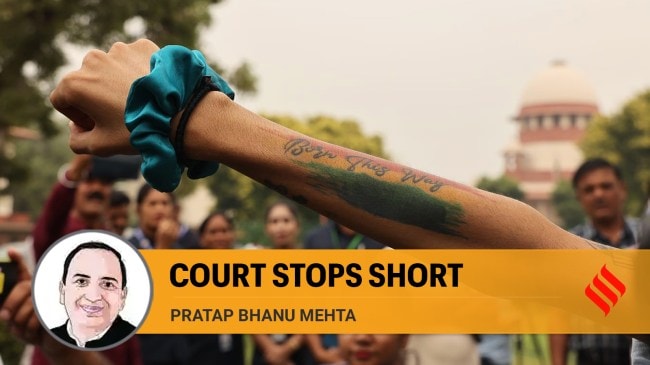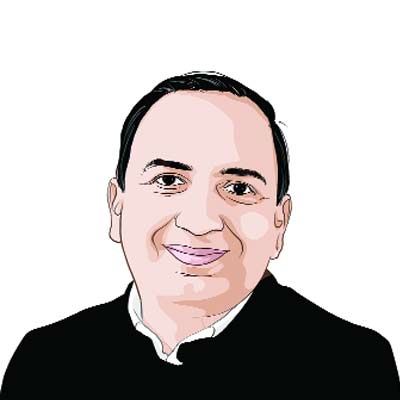Opinion Pratap Bhanu Mehta writes: On marriage equality, the Supreme Court stops short
There is a quip going around about the current Court: They proclaim values with the high-mindedness of philosophers, thread fine lines on process with the ingenuity of lawyers, give history lessons with an erudition that shames historians. But ultimately, the directions cause the executive no discomfort
 This judgment will only prolong the long and arduous struggle to create the conditions where same sex couples could live a life without fear, in the sweet elixir of freedom, and the imprimatur of equal recognition. (Express Photo by Tashi Tobgyal)
This judgment will only prolong the long and arduous struggle to create the conditions where same sex couples could live a life without fear, in the sweet elixir of freedom, and the imprimatur of equal recognition. (Express Photo by Tashi Tobgyal) In its latest judgment, the Supreme Court of India has taken some steps to protect same sex unions from discrimination, and granted those unions some legal rights. But in the final analysis, the Court limited itself to providing a mere modus vivendi: Protecting a few rights, but stopping well short of granting full recognition to same sex marriage.
The Chief Justice was not aligned with at least three of his colleagues, but what is odd about his judgment is that it was not allied with its own logic. This judgment will only prolong the long and arduous struggle to create the conditions where same sex couples could live a life without fear, in the sweet elixir of freedom, and the imprimatur of equal recognition.
The Chief Justice’s judgment begins with a profound reiteration of the values that protect the dignity of individuals: A regard for their autonomy, privacy, freedom to choose and their well-being. The basic thread around which it constructs an argument is this: No one can be denied a human good that should be available to them solely on account of their sexual orientation. It then gives a series of directions to protect same sex unions from interference by the state, or in some cases, parents. But it stops well short of extending the provisions of the Special Marriage Act to same sex unions.
It could be argued that this was a wise course of action given two background features of this case. The first is whether this is a matter for the judiciary or Parliament to decide. I am very sympathetic to this question. The Court should not wade into policy. But here the issue is whether a statute discriminates against a class of people with no reasonable nexus for that classification.
The Court argued that it could neither invalidate the Special Marriage Act nor read it in a more inclusive non-discriminatory way. This, to be honest, is a very odd position to take, if what is at stake is discrimination. In effect, the Court is saying that, for the moment, a certain institutional practice, marriage, that this society recognises as a central pivot around which to publicly express unions between two people, is not available to same sex couples. All judges seem to agree that the institution of marriage flows from the statutes created by the state. They argue that it follows from this that there is no fundamental right to marriage, and that such an institution cannot be modified by the Courts.
But surely this is to miss the Court’s own logic twice over. First the issue is not whether marriage is a statutory right. It is whether an important institution can be denied to two people wanting to create a union solely on account of their sexual orientation, which is what the Special Marriage Act does. So the CJI enunciated the principle of discrimination with one hand, only to limit its applicability to the real issue at stake. And second, as Justice Ravindra Bhat pointed out, if the Court is reluctant to employ the discrimination logic to the Special Marriage Act, why apply it to regulations regarding parenting etc? Is the Court saying the question of discrimination cannot apply to something that is not a fundamental right?
The second is a tricky issue of how far society should proceed without a deep consensus. To what extent can courts instigate moral change, without incurring a backlash? As Justice Sanjay Kishan Kaul said rightly, constitutional morality cannot be shaped by social morality: That argument would equally apply to parenting practices that the Court seeks to modify, as it would to the institution of marriage. The current law embodies a discriminatory assumption that only heterosexual parents can, as a couple, be appropriate parents. The Chief Justice’s opinion rightly questions this. But why not wait for Parliament on this question as well?
If one is sympathetic to the courts, one can say this. They have followed an incrementally ameliorative logic. They do not feel confident about the administrative and social consequences of reinterpreting the Special Marriage Act and they are letting the social debate play out. But this would be very charitable. The genius of the strategy to use the Special Marriage Act to grant same sex unions recognition was that it, for the moment, leaves the whole wider gamut of personal laws intact. It was not a whole-scale transformation of marriage practices as much as the recognition of discrimination.
Why is the non-recognition of marriage discriminatory? Whether we like it or not, marriage is a privileged social institution. Justice Kaul seems to think some of the aims of marriage can be achieved by a form of civil union. Justice Chandrachud wants to grant some rights, like those of a civil union, without quite specifying what kind of a union it is. Again, this relegates same sex union to a fugitive identity that cannot even be clearly named, let alone fully recognised.
The meaning of marriage, the conception of the goods it supports, has undergone a profound transformation, But two related ideas remain central. The first is its “publicness”. It is a social institution. It has to be publicly affirmed and recognised by society. The second element is commitment. The idea behind commitment is not that a bond cannot be dissolved: That depends on circumstances. It is the idea that this relationship is meant to be non-instrumental: The parties are committing not merely to use each other as means, but to treat each other’s well-being as an end in itself.
It is not merely a transactional existence, but comes with a deeper set of rights and obligations, which at their best, are an expression of that non-instrumentality. It is true that this non-instrumentality can be expressed in non-legal forms. But society’s recognition of marriage is a public recognition of that form of commitment that is being denied here. The point of overlapping consensus that could be crafted between different ideologies is that granting recognition to same sex marriage would have signalled a society commitment to the publicness and non-instrumentality embodied in that relationship. Same sex marriage is an affirmation of the value of marriage, not a departure from it.
There is a quip going around about the current Court: They proclaim values with the high-mindedness of philosophers, thread fine lines on process with the ingenuity of lawyers, give history lessons with an erudition that shames historians. But ultimately, the directions cause the executive no discomfort. Alas, in its ameliorative confusion, the Court has done nothing to dispel that notion.
The writer is contributing editor, The Indian Express






